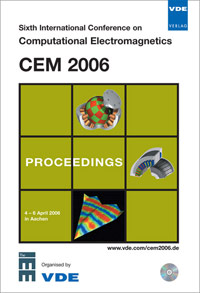Modelling of the electric potential distribution in a thorax phantom for Electrical Impedance Tomography using the Finite Element Method
Conference: CEM 2006 - 6th International Conference on Computational Electromagnetics
04/04/2006 - 04/06/2006 at Aachen, Germany
Proceedings: CEM 2006
Pages: 2Language: englishTyp: PDF
Personal VDE Members are entitled to a 10% discount on this title
Authors:
Luepschen, H.; Steffen, M.; Leonhardt, S. (Chair for Medical Information Technology, RWTH Aachen University)
Riesen, D. van; Henrotte, F.; Hameyer, K. (Institute of Electrical Machines, RWTH Aachen University)
Abstract:
Electrical impedance tomography (EIT) is a non-invasive technique for the estimation with a high temporal resolution of the spatial impedance distribution in a cross section of the body. Electrodes are attached around the domain of interest (e.g. the thorax). Small alternating currents are injected and potentials are measured and used for reconstruction. The reconstructed impedance images can be particularly useful for the treatment of patients with acute respiratory distress syndrome (ARDS). This severe disease is characterised by atelectases and lung oedema and, thus, changes of the impedance distribution in the thorax. An electrolytic thorax phantom is used for the analysis of different pathology states. It contains simple functional units that mechanically simulate heart and lung. In order to increase flexibility regarding the positioning of the electrodes, the simulation of the pathology, the positions of the organs and tissue properties, a parameterised adjustable 2D-model has been developed. The potential and current distributions are computed using the finite element method (FEM). The obtained images show the potential for automatic closed-loop parameterisation and reconstruction algorithm evaluation.


